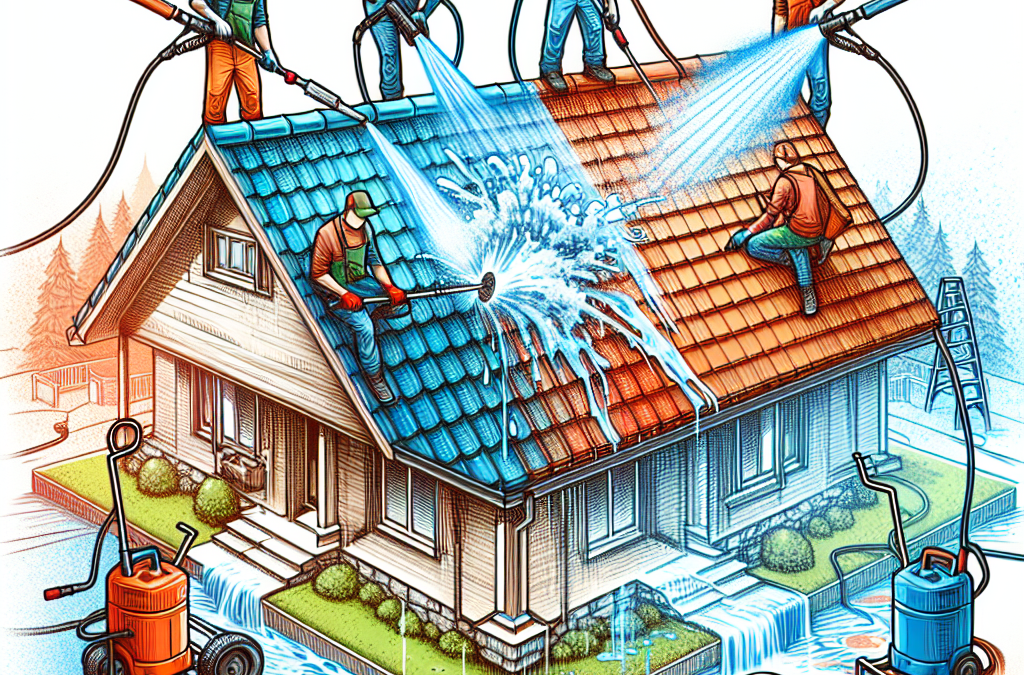Is it OK to Pressure Wash a Roof?
When it comes to cleaning the exterior of your home, one area that often gets overlooked is the roof. Over time, roofs can accumulate dirt, algae, moss, and other debris that can not only affect the aesthetics but also the longevity of your roof. Many homeowners wonder if pressure washing is a viable option for roof cleaning. In this article, we will explore whether it is safe to pressure wash a roof and discuss alternative methods to effectively clean your roof.
Table of Contents
- Why people consider pressure washing their roof
- The risks of pressure washing a roof
- Alternative methods for cleaning a roof
- Key takeaways
- FAQs
- Conclusion
Why people consider pressure washing their roof
Pressure washing is a popular method for cleaning various surfaces around the home, such as driveways, decks, and siding. It utilizes high-pressure water to remove dirt, stains, and grime effectively. It’s no wonder that some homeowners might consider using this method to clean their roofs as well. Here are a few reasons why people might think about pressure washing their roof:
- Efficiency: Pressure washing can quickly and easily remove dirt, algae, moss, and other debris from the roof’s surface.
- Cost-effective: Renting or hiring a pressure washer is generally affordable, making it an attractive option for homeowners on a budget.
- DIY-friendly: Pressure washing can be done by homeowners themselves, without the need to hire professional cleaners.
While these reasons may seem compelling, it is essential to consider the potential risks involved in pressure washing a roof before proceeding.
The risks of pressure washing a roof
Although pressure washing can be effective for cleaning certain surfaces, it is generally not recommended for roofs. Here are some of the risks associated with pressure washing a roof:
- Damaged shingles: The high-pressure water can dislodge or damage the protective granules on asphalt shingles, leading to premature deterioration.
- Water infiltration: Pressure washing can force water underneath the shingles, causing leaks and water damage to the underlying structure.
- Voided warranties: Many roofing manufacturers explicitly state that pressure washing can void the warranty on their products.
- Personal injury: Working on a roof poses inherent risks, and using a pressure washer adds another layer of danger. Slippery surfaces, high-pressure water, and working at heights can increase the risk of accidents and injuries.
Considering these risks, it is best to explore alternative methods for cleaning your roof that are safer and equally effective.
Alternative methods for cleaning a roof
Fortunately, there are alternative methods available to clean your roof without resorting to pressure washing. Here are a few options:
- Soft washing: Soft washing is a low-pressure cleaning method that uses specialized detergents to remove dirt, algae, and moss from the roof’s surface. It is gentle yet effective and does not pose the same risks as pressure washing.
- Chemical treatments: Certain chemical treatments can be applied to the roof to kill algae, moss, and other organic growth. These treatments often require professional application and should be used with caution.
- Manual cleaning: For smaller areas or specific spots on the roof, manual cleaning using a brush or broom can be a viable option. This method requires more time and effort but eliminates the risks associated with pressure washing.
Before deciding on the best method for your roof, it is recommended to consult with a professional roofing contractor who can assess the condition of your roof and provide expert advice.
Key takeaways
- Pressure washing is generally not recommended for cleaning roofs due to the potential risks involved.
- Pressure washing can damage shingles, cause water infiltration, void warranties, and pose a risk of personal injury.
- Alternative methods such as soft washing, chemical treatments, and manual cleaning are safer and equally effective for cleaning roofs.
- Consulting with a professional roofing contractor is advisable to determine the best cleaning method for your specific roof.
FAQs
Q: Can pressure washing remove moss from my roof?
A: Pressure washing may remove visible moss from the surface of the roof, but it does not address the root cause of the moss growth. The moss is likely to return unless the underlying conditions that promote its growth are addressed.
Q: How often should I clean my roof?
A: The frequency of roof cleaning depends on various factors, such as the climate, surrounding vegetation, and the type of roof. As a general guideline, it is recommended to clean your roof every 2-3 years or as needed.
Conclusion
While pressure washing may be suitable for cleaning other areas of your home, it is generally not recommended for roofs due to the potential risks involved. Damaged shingles, water infiltration, voided warranties, and personal injury are some of the risks associated with pressure washing a roof. Instead, consider alternative methods such as soft washing, chemical treatments, or manual cleaning. Consulting with a professional roofing contractor can help determine the best approach for safely and effectively cleaning your roof.


Recent Comments